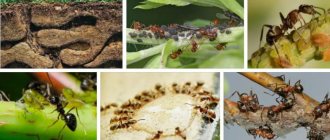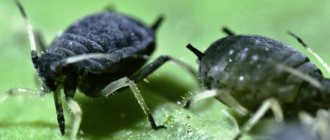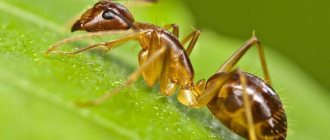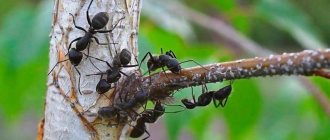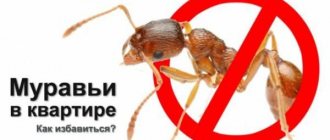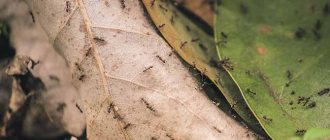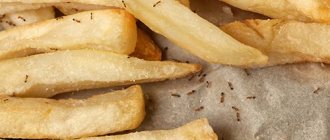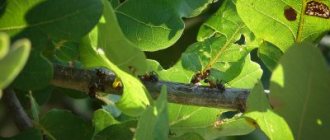A colony of ants in a garden bed is a dubious joy for a gardener, and the appearance of such newcomers in a greenhouse is a double disappointment. After all, in a place where the most comfortable conditions have been created that protect plants from the vagaries of weather and diseases, the last thing I would like to see is “neighbors” causing damage to the harvest. We tell you what folk methods will help drive ants out of the greenhouse.
Repelling ants with herbs
Ants are considered susceptible to the strong odors that some plants emit. This property is used to drive insects out of the greenhouse. Suitable for “aroma fighting”:
- mint;
- sagebrush;
- carnation;
- garlic;
- mustard.
Herbs are laid out between greenhouse plants. Ants especially do not like the smell of garlic. It is recommended to grind it, add it to sawdust and sprinkle the mixture near the entrance to the anthill. An infusion made from a head of garlic and a bucket of water is more effective. After keeping the mixture for a day, it is watered where insects are active.
The disadvantage of this method is that the ants will simply change their location, but after a while they can return again.
Use of insecticides
Before planting plants in a greenhouse, it is usually treated for pests. You can also use many products to treat greenhouses and greenhouses with plants already planted in them, but before the active formation of ovaries and fruiting. Typically, recommendations indicate that anti-ant treatment should be carried out no later than 20 days before harvest.
Typically, chemicals in the form of powders or granules are used to kill insects. They are poured in places where insects accumulate in a layer of up to 4 cm and sprinkled with soil on top. There are also preparations for dilution in water: the solution is poured onto the soil. If there are horizontal structures inside that are free from soil, insecticides can be applied to them in the form of a gel.
What means to use to fight ants
When digging up the soil, it is convenient to use granules, and the walls of the greenhouse and paths between the beds can be washed, sprayed, or shed generously with liquid products. For example, you can use Medilis-Super, Medilis-Ziper, Medilis-Neo. They are diluted in water in accordance with the instructions; they can be used to wipe surfaces or spray. Products in the form of gels, for example, Medilis-Antimant or Medilis-Anti-Cockroach, are not very convenient to use in a greenhouse. It is better to squeeze the gel onto a flat surface, and there is not too much free space in the greenhouse or greenhouse. But you can use them too.
Using boric acid to fight ants
Experienced gardeners call boric acid one of the best alternative means for fighting ants. The drug acts as a high-quality insecticide, but does not harm plants and does not accumulate in fruits.
To prepare the bait you will need:
- 10 g boric acid;
- 2 tsp. honey;
- glass of water.
Heat the water until it is slightly above room temperature. Dissolve boric acid and natural honey in it. We pour the resulting mixture into nylon lids and place the bait next to the anthill and on active trails.
Destruction of the uterus
It often happens that after a serious chemical treatment is completed, insects disappear for a certain period of time and then appear again. Pesticides kill only adult individuals, while the queen continues to actively reproduce.
The queen lives in the depths of the galleries and is extremely difficult to find. Therefore, experts have come up with the most effective way: you need to make sure that the poison gets to the female from the ants. When it is destroyed, the nest will also spread.
To destroy pests in a greenhouse, you need to get rid of the main root of the problem - their uterus. For these purposes, you will need to dig up the soil, as well as carefully examine it, trying to find the largest ant that lays eggs.
Wait for her to appear
Regular loosening of the soil near plants also helps reduce the number of pests, or forces them to change their habitat. This is due to the fact that the nests and passages that are used for movement are constantly being destroyed. When, during loosening, it was possible to find and get rid of the queen, the anthill ceases to exist.
Preparation of a weak poison
When the poison left by insects acts very quickly, they do not have time to convey it to the female. And if the effect is insignificant, slow, over time the queen will be killed.
To prepare a weak bait, an ordinary sweet solution of boric acid is made, in which cotton wool should be soaked and thrown inside the jar. The trap is covered in such a way that insects can get inside. They bite off pieces of cotton wool and bring it to the female. After 15 days, you need to update the contents, reducing the concentration of the solution over time. After 6 weeks, the colony will be completely destroyed.
In addition, you can mix honey and dry boric acid in a ratio of 2 to 1, add 2 drops. water and stir, making the mixture quite thick. Such bait is placed on ant paths. After this, you need to wait for it to be delivered to the female. If the acid penetrates inside the ant, it will initially begin to itch and then be destroyed.
Using semolina to fight ants
A folk method based on the characteristics of the digestive system of ants. The absorbed cereal is not digested, but swells, which leads to the death of the insect. The advantage is that the ants can also serve semolina to their queen as food. If this happens, you will defeat the entire family.
To make semolina more attractive to insects, it is recommended to mix it with powdered sugar. The resulting mixture is scattered along the paths, paying special attention to the entrances to the anthill.
How do ants harm a greenhouse?
On the one hand, ants bring undoubted benefits to the garden. In a day, the inhabitants of one anthill can destroy up to two thousand larvae, midges, caterpillars, slugs and their eggs. In addition, ants help disperse the seeds of plants such as thyme, speedwell and sweet violet.
However, there are much more troubles from ants in the country. Why are they bad?
- They eat the fruits of sweet varieties of vegetables;
- damage the inflorescences, which results in the formation of irregularly shaped fruits;
- spread weed seeds;
- in the process of their life activity they release a lot of acid, which is why the soil in the vicinity of large anthills may become unsuitable for crops that prefer neutral and alkaline soil;
- damage plant roots in the process of digging tunnels for anthills;
- attack people, which brings a lot of inconvenience while working in the garden beds;
- They breed aphids, sometimes turning a greenhouse or greenhouse into a place for “grazing” of the pest.
The main danger from such a neighborhood is that at first you may not even notice that the insects have settled in the immediate vicinity of the greenhouse or have “moved” into it altogether. Even if you have learned to coexist with these insects quite peacefully, this does not mean that at some point an ant that runs in “on reconnaissance” will not bring with it a good hundred comrades.
Using wood ash to fight ants
Most often, gardeners use wood ash for fertilizing, but it is also an effective means for eradicating pests. To drive away ants with its help, the combustion product directly with smoldering coals must be poured onto an open anthill. After a couple of weeks, the procedure is repeated.
Fighting methods
As already mentioned, there are a huge number of methods of struggle. You can use strong chemicals, resort to physical methods, or use old and proven folk recipes. Let's look at the most popular and effective methods of control.
Physical methods
So, you need to thoroughly inspect the greenhouse, get rid of all unnecessary things, for example, old boards, pieces of slate, etc. You also need to get rid of rotten wood. In this way we will disrupt their normal way of life and spoil their ideal conditions.
You need to dig up the soil, ideally find the nest and the queen itself, which will completely get rid of the problem. Be sure to dig up the soil again in the fall and then in the spring. If you find an anthill, you need to pour boiling water into the passages or use a mixture of quicklime, soda and ash.
Chemicals
The range of specialized preparations is very large; they allow you to quickly and most effectively get rid of pests. But they always resort to the help of just such drugs, since they contain pesticides that will not benefit the crop.
In addition, such toxic chemicals are dangerous for people and animals. Their use requires strict adherence to the instructions and implementation of all safety measures.
There are several groups of drugs:
- Gels. These are substances that are produced in the form of a gel and have a prolonged effect. They are used before planting occurs. The active substances that are included in the composition enter the body of ants and lead to their death.
- Powders. They are used on the ground, poured a layer and covered with soil on top. They work as bait, eating the powder, the insect dies.
- Chalk. They work as repellents by releasing an unpleasant aroma for insects.
Speaking about popular drugs, it is worth highlighting Grom-2, Anteater, Ant, Muratsid. Their action is carried out thanks to the main active component diazinon. This is a fairly strong substance that acts in an enteric contact manner and can quickly remove pests. There is also a drug with the same name on sale.
It is also useful to know that when treated with a pesticide, the ants do not die instantly, but only after 1-2 days. Remember that it will not be possible to remove them forever; then you will need to resort to preventive actions that will prevent re-infections.
Repellent scents
Ants sense aromas very well and they do not like some of them at all. If they detect an unpleasant odor, it makes them anxious and they avoid areas where it is present.
Thanks to this effect, it is possible to use natural remedies that have repellent aromas in greenhouses as preventive measures. These include mint, wormwood, cinnamon, garlic, and much more.
The most popular means:
- Garlic. You can use garlic cloves, which must be crushed very tightly to make a paste. Next, the pulp is mixed with sawdust and can be used. It is very effective to use this mixture on anthills by sprinkling it. Garlic arrows are also used; they must be placed in the greenhouse according to the structure itself.
- Ammonia. Take 10 liters of water and add 100 ml. alcohol, napkins are moistened in the solution and laid out near the aisles. You can also prepare a solution for irrigation; to prepare it you will need 2 liters of alcohol per bucket of water.
It is also very effective to dust the plant; for this, slaked lime, ground pepper, ammonium nitrate or ash are used.
Traditional methods
Folk methods of struggle are no less popular; their effectiveness has been proven by time; let’s consider the most popular:
- Jam. You can make traps using jam. To do this, take a plastic bottle and cut off the bottom of it. The inside walls are coated with a sticky treat. When they run to eat, they will end up on a sticky surface from which they will not be able to free themselves.
- Herbs. In this case, you can use aromatic mint, wormwood or cloves. You can use it in any form, for example, lay it out near an anthill or near plants. Such aromas will help get rid of them, but remember that they will not die, but will go to look for another place to live, and most likely it will be the nearest flowerbed.
- Potato. We use it raw; you just need to peel it and cut it into pieces, which are then placed in a greenhouse. These insects do not digest starch, so this treat will be an excellent way to combat them.
- Kerosene. From it you need to prepare a solution that is used to treat areas where pests accumulate. To do this, take a bucket of water and add 2 teaspoons of kerosene; such a concentration will not harm the plants.
- Ammonia. This substance has harmful effects. Take 5 liters of water and dilute 2 tbsp in them. alcohol After which the solution is poured into the passages of the anthill. You can prepare a solution of lower concentration, which is used to treat plants. Only 10 ml is needed for 10 liters. alcohol
- Millet. This method is one of the oldest, but is still very popular today. It works as follows: you need to scatter millet near the anthill, they will definitely want to try the treat, but such food is not digested, which will lead to their death.
- Boric acid. For this product you need a mixture of acid 5 g, water 50 ml, sugar 50 g. Next, the mixture is placed in small containers and placed in the greenhouse. It is necessary to work with these substances very carefully; children and animals should not be allowed to come into contact with it.
- Soda. A very affordable and effective method. You can use a mixture of soda and powdered sugar, which is sprinkled on the anthill. You can also prepare a solution from soda and boiling water; it is also used.
Making traps for ants
You can reduce the number of ants in a greenhouse using simple traps. Glass jars with leftover jam are suitable for such purposes. The sweetness will attract insects, but they will not be able to get out. Brewer's yeast mixed with honey can also be used as bait. Place a couple of spoons of the mixture at the bottom of the jar, then place the vessels along the ant path.
Since only working insects suffer from this method, over time the queen will restore the population. But traps will help buy time until more radical methods take effect.
Methods for removing ants from a greenhouse or greenhouse
I’ll tell you about methods for removing ants from the garden, which I tried from my own experience. At the beginning of an ant invasion, I limit myself to agrotechnical and old-fashioned methods. Specialized pesticides are a last resort for me.
Use of specialized tools
I will present the effective anti-ant drugs known to me - both traditional and innovative:
- Ultrasonic repeller. The universal device, harmless to humans and plants, has a depressing effect on a number of pests - from aphids and ants to mole crickets and moles. One minus is that the repeller must work constantly.
- "Ant-eater". The product is good for spot control - this drug alone cannot cope with a large-scale pest invasion.
- "A great warrior". The gel preparation contains not only a potent poison, but also a delicacy that attracts ants. The pests flock to the “free buffet” and soon die.
- "Thunder-2". These anti ant granules are an effective remedy. I place them in places where pests accumulate and where pests move - soon the ants disappear from the greenhouse.
- "Mashenka." Chalk is designed to fight cockroaches, but is no less effective against ants. I decorate boards and stones with it, and arrange these objects in the greenhouse. Particles of the drug stick to the legs of the ants, from where they enter the nest and poison the entire colony.
- "Absolut-gel". One of the new effective drugs. The ant nest is sprayed with liquid from a syringe. The product is very tasty for insects - they certainly take it to the uterus. She, having tasted the poison, dies - with her death, the pests look for a new place for nesting.
Keep in mind that most special drugs are dangerous for humans and can lead to severe poisoning. Therefore, only use them according to the instructions, do not forget about personal protective equipment and the waiting period before harvesting.
ultrasonic repellers against garden pests
Agrotechnical methods of controlling ants
Now I’ll tell you about natural methods of removing ants - safe, environmentally friendly and economical.
Fighting cash cows
I have already noted that one of the reasons for the appearance of ants in greenhouses is the breeding of aphids in comfortable warm conditions. Once you destroy the “cash cows,” the ants will go away. I quickly get rid of aphids using simple folk methods:
- Spraying with Cola or Pepsi. I pour sweet soda into a spray bottle, spray bottle, and treat the plants. The aphid sticks to the liquid and, immobilized, dies. Then it remains to carry out drip irrigation to wash it off the tops.
- Mechanical removal. I inspect, tear off the leaves on which aphid colonies have settled, and then burn them. But the method is good only for adult plants.
- Soap solution. I dilute 2 tbsp. spoons of laundry soap shavings in 2 glasses of water. I spray the greenhouse plantings with the resulting mixture.
In order to quickly get rid of uninvited guests, I hasten to simultaneously fight the ants themselves.
Destruction of the Queen
Since I don’t have time to “hunt” the ant queen, I use a trick: I prepare tasty baits that the working insects themselves deliver to their queen:
- I dilute the sweet solution and add boric acid (1:10) to it. I soak pieces of cotton wool in the liquid and leave them in the greenhouse. The ants will bite off a piece of the sweet material and take the “treat” to the queen. Every 1-2 weeks I renew the bait - after 1-1.5 months of such “lazy struggle” the ant nest eliminates itself.
- I mix liquid honey with boric acid powder 2:1, add a little water so that the mixture is similar in concentration to sour cream. I place bait on the ant passages - sooner or later the servant ants will treat their queen with poison.
One of the modern methods for combating the uterus is the Bazudin poison. The product looks like ant pupae, which confuses the pests - they carry the pesticide into their nest, poisoning the larvae, drones, and queen. With her death, life in the anthill comes to a standstill - the orphaned pests go looking for a new place to live.
“Repellent” plants
We must not forget that ants are extremely disgusted by plant odors, which are tolerable and even pleasant to humans:
- cinnamon;
- coffee grounds;
- Melissa;
- tansy;
- parsley;
- lavender;
- marigold;
- nasturtium;
- fennel;
- Melissa;
- rosemary;
- catnip;
- lemon;
- sagebrush;
- carnation;
- mint;
- anise;
- laurel;
- garlic;
- elder.
As a deterrent and preventative measure, it would be a good idea to decompose and scatter such products in the greenhouse and update the “repellents” if necessary. Or plant fragrant plants around the perimeter of the greenhouse.
marigolds as a measure to repel ants
How to get rid of ants using traditional methods
I’ll also tell you about my grandmother’s and grandfather’s simple, safe, time-tested methods of fighting ants.
Destruction of an anthill
Vegetable oil is effective against ant dwellings - it does not have to be fresh. I save the burnt stuff left over from frying or deep-frying and pour it into the homes of uninvited ants.
I don’t forget about effective dusting - I sprinkle the following on the greenhouse anthill:
- ground black or red pepper;
- tobacco dust;
- ash;
- fluff lime;
- dry mustard;
- ammonium nitrate.
Grandma's tricky way: sprinkle millet on an ant's nest. The ants confuse it with their own eggs and actively drag it into their home. As soon as the insects have done their job, start periodically watering the anthill. The millet will swell and sprout, barricading the passages and exits from the pests’ home. Another unpleasant effect for ants is the disgusting smell of swollen millet.
Lures
One of the effective ways to combat garden ants is boric acid bait. I use my grandfather’s effective recipes:
- With egg. I break a raw egg into one container and add 3 bags of boric acid. I stir the mixture until smooth – the bait is ready.
- With sugar. For one glass of water - 2 glasses of sugar, 2 tbsp. spoons of boric acid. I dissolve the composition to a homogeneous mass - the product is ready.
It is enough to spread the bait on ant paths - the product will act on pests both when it comes into contact with the body and when consumed internally.
I will also share other bait recipes invented by resourceful gardeners:
- Meat. At 2 tbsp. spoons of any minced meat - ½ spoon of boric acid. Stir well, make tiny “meatballs”, place them in the greenhouse. The “treat” is also attractive to pets - make sure they don’t get into the greenhouse.
- Yeast and honey. Having tried such a treat, the ant will die. The mass death of brothers will scare away the surviving individuals from the greenhouse.
- A jar with leftover jam. Take advantage of the fact that ants have a big sweet tooth. Leave the jar on its side in the greenhouse.
By the end of the day, a considerable number of pests will gather in it - “sink” the container in a prepared bucket of water.
Baits are good because they poison not only the worker ants, but also the queen and drones - the servants bring poisonous food to the nest.
Removal agents
I will also present recipes for folk remedies for ant exterminators:
- Shampoo, vinegar and oil. For 10 liters of water - 2 cups of vegetable oil, a bottle of vinegar, 2 cups of the cheapest shampoo. I mix the mixture thoroughly and pour it into the sprayer. I spray the area with the largest concentration of ants with the mixture, cover it with film, thick polyethylene, or a tarpaulin for 2-3 days.
- Garlic infusion. For 5 liters of water – 2-4 heads of garlic. I crush the cloves in a garlic press, fill them with cold water, and leave for a day. The next day I treat the anthill with the composition.
- Wormwood infusion. I pour boiling water over 300 g of wormwood, then pour 10 liters of cold water over it. I let it sit for several hours, then, without diluting it, I carefully water the anthills with the mixture.
- Mustard infusion. For 1 liter of water – 60 g of mustard powder. Mix the mixture thoroughly, close with a tight lid and leave for about 3 days. Then I dilute the concentrate with 3 liters of water, water the anthill and insect paths with the working solution.
- Kerosene water. For 5 liters of water – 2 tbsp. spoons of kerosene. To drive out ants, it is enough to pour the mixture into their homes.
- A solution of bleach, carbolic acid. I fill the dry substance with water 1:5 and pour the solution over the ant’s place of residence.
- A solution of karbofos or formaldehyde. I prepare the working mixture by diluting the dry substance with water 1:10. The solution is suitable both for treating anthills and for preventive disinfection of the entire greenhouse - internal structures, cracks. For “medicinal” purposes, the mixture is used 2-3 times to completely expel ants.
I advise you to use all the products not once, but several times, leaving for 3-5 days.
Smell repellent
I don’t forget to take advantage of the great dislike of ants for certain odors:
- Garlic. I break off the shoots of the plant, lay them out in the greenhouse, periodically replacing them with fresh ones. Another option is to make a kind of fence around the greenhouse from the tops and garlic shoots.
- The smell of sunflower oil. The product can be rubbed into unnecessary planks and placed in the interior spaces of the greenhouse.
- Aroma of mint, elderberry, wormwood, cinnamon. I place fresh twigs and sticks directly on ant paths, on beds with plants - pests prefer to avoid them.
- A decoction of delphinium or aconite roots. I pour the strained liquid into the anthills late in the evening, when the pests return to their homes.
Don't forget about a simple law - the more countermeasures you use at the same time, the faster you will drive the uninvited guests out of the greenhouse.
ants in the garden
What to do
There are many methods that can help if there are ants in the greenhouse. The effectiveness of these methods varies, but from them each gardener will be able to choose the most suitable one for his garden.
All these methods can be divided into a number of groups:
- Physical.
- Chemical.
- Combined.
- Industrial pesticides.
Let's take a closer look at each of these methods.
Physical
First of all, you need to find places that ant families have chosen for themselves. These insects love to settle under old boards, sheets of slate or roofing felt lying on the ground, as well as in the wooden structures of greenhouses and greenhouses themselves, especially if the wood is rotten.
Thus, if you remove wood from greenhouses, thereby depriving insects of comfortable living conditions, you can reduce their colony.
Before you start planting, you can spill the entire soil with an aqueous solution of soda and linseed oil (5 g of soda and 30 g of linseed oil per 1 liter of water), which will force the ants to leave the greenhouse.
If you are willing to spend the time and effort to excavate in your own greenhouse, you can dig up the ants' nest and find the queen. By destroying it, you will destroy the entire settlement.
Deep digging of the soil in the greenhouse in the fall and spring, as well as frequent loosening of the soil in the summer months and regular sprinkling of discovered anthills and tunnels with ash, baking soda or quicklime will lead to the colony leaving the territory.
All about ants
In nature, ants are insects that prefer to live in large numbers of individuals, and for this they build huge anthills for themselves. In one such anthill, there is basically one queen, which lays larvae for reproduction. The rest of the inhabitants of the nest are engaged in collecting building material, which will later be used to expand the housing area, and also obtain food.
It is during the production of food that insects become dangerous to gardeners. At this time, ants love to eat juicy and sweet berries, vegetables and root crops. We have discussed in detail the methods of combating garden ants in a separate article.
The appearance of new insect individuals occurs in a fairly short period of time; small insects are born approximately every two months, and this necessitates the need to expand living spaces and increase the amount of food production.
Adult ants are able to mark the path they have traveled and thus trample a path for themselves, with the help of which it is easier to carry prey to their home. With the help of the specific smell that one ant leaves, other insects find the place of its prey and transfer food to their anthill.
To prevent ants from trampling the path to the greenhouse, the owner is faced with a task, a barrier that can be achieved with the help of specific aromas. To obtain such a specific smell, gardeners often use mint, mustard or garlic.
Although there are many types of insects such as ants, only a few of them appear in greenhouses and vegetable gardens:
- forest ants, which are red in color, often appear in summer cottages located near forests and plantings;
Black garden ants - garden ants are black in color, they often appear in greenhouses and feed on young plant roots and new shoots;
- In greenhouses you can find brown meadow ants, but this species is less likely than others to climb into such structures.
Garden ants are considered the most frequent guests of greenhouses; if their number in a greenhouse rapidly increases, then it is better to exterminate them. How to get rid of garden ants is of interest to many. We will tell you in detail how to do this and offer the most effective options.
Using Vinegar and Soda
Baking soda is a universal remedy that will help get rid of many problems. You need to use a small amount of soda, then it will not harm the earth. You can use soda as follows:
- 2 tbsp. soda must be diluted with two liters of boiling water. The soda must be stirred well, and after that, pour it all into the anthill, pour it directly into the passages. The treated areas must be covered with earth or covered with dense material to prevent oxygen from entering;
- Baking soda can also be used in dry form by mixing it with powdered sugar. The ants will mistake the mixture for food because of the sweet aroma and the soda will kill them;
- You can also use a mixture of baking soda and vinegar to get rid of pests. To use this mixture, you need to make a small depression in the anthill and pour soda into it. Vinegar should be poured on top of the soda, after the reaction has passed, the crater should be covered with earth.
As you can see, soda can be used in any form; it will help get rid of insects, even if you just sprinkle it around the anthill. However, it will act for a long time, so it is better to use the methods described above, they act faster.
